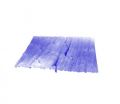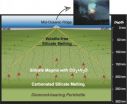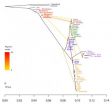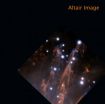(Press-News.org) This press release is available in German.
Dental microwear, the pattern of tiny marks on worn tooth surfaces, is an important basis for understanding the diets of fossil mammals, including those of our own lineage. Now nanoscale research by an international multidisciplinary group that included members of the Max Planck Institute for Evolutionary Anthropology in Leipzig has unraveled some of its causes. It turns out that quartz dust is the major culprit in wearing away tooth enamel. Silica phytoliths, particles produced by plants, just rub enamel, and thus have a minor effect on its surface. The results suggest that scientists will have to revise what microwear can tell us about diets, and suggest that environmental factors like droughts and dust storms may have had a large effect on the longevity of teeth. In particular, East African hominins may have suffered during dust storms, particularly from particles carried in by seasonal winds from the Arabian peninsula.
New research published by the scientists in Leipzig suggests that the main cause of the physical wear of mammalian teeth is the extremely hard particles of in soils in many parts of the world. To show this, single particles were mounted on flat-tipped titanium rods and slid over flat tooth enamel surfaces at known forces. Quartz particles could remove pieces of tooth enamel at extremely low forces, meaning that even during a single bite, these particles could abrade much of the surface of the tooth if they are present in numbers.
In contrast, fossilized plant remains, so-called phytoliths, indented the enamel under the same conditions, but without tissue removal. The effect of the considerably softer phytoliths is similar to that of a fingernail pressed against a softwood desk. This kind of mark, called a rubbing mark, is visible but purely cosmetic.
The Max Planck Institute's Amanda Henry provided the phytoliths for the study, and assisted in the interpretation. "This study suggests that phytoliths do affect teeth, but in a different manner than we previously thought," she says. A new theory of wear, developed by collaborator Tony Atkins from Reading in the UK, suggests exactly what geometrical and material conditions are required for abrasive versus rubbing contacts. "People have not realized the vital importance of factoring fracture toughness into wear analyses" says Prof. Atkins. Study leader and Kuwait University researcher Peter Lucas says "we think that we've gone a lot further with the analysis of microwear than previous investigations because we realized that to uncover the mechanisms that cause it, you need to go one level smaller – to nanoscale. It is only then that the difference between relatively innocuous rubbing contacts and those that remove tooth tissues becomes clear." The team could distinguish between marks made by quartz dust, plant phytoliths, and also by enamel chips rubbing against larger pieces of enamel.
INFORMATION:
Original paper:
Lucas PW, Omar R, Al-Fadhalah K, Almusallam AS, Henry AG, Michael S, Arockia Thai L, Watzke J, Strait DS & Atkins AG. Mechanisms and causes of wear in tooth enamel: implications for hominin diets.
Journal of the Royal Society Interface. Published online, Journal of the Royal Society Interface, published online January 9, 2013
Particles of crystalline quartz wear away teeth
Study questions informative value of dental microwear for dietary habits of extinct species
2013-01-10
ELSE PRESS RELEASES FROM THIS DATE:
First image of insulin 'docking' could lead to better diabetes treatments
2013-01-10
A landmark discovery about how insulin docks on cells could help in the development of improved types of insulin for treating both type 1 and type 2 diabetes.
For the first time, researchers have captured the intricate way in which insulin uses the insulin receptor to bind to the surface of cells. This binding is necessary for the cells to take up sugar from the blood as energy.
The research team was led by the Walter and Eliza Hall Institute and used the Australian Synchrotron in Melbourne, Australia. The study was published today in the journal Nature.
For more ...
Magma in mantle has deep impact
2013-01-10
HOUSTON – (Jan. 9, 2013) – Magma forms far deeper than geologists previously thought, according to new research at Rice University.
A group led by geologist Rajdeep Dasgupta put very small samples of peridotite under very large pressures in a Rice laboratory to determine that rock can and does liquify, at least in small amounts, as deep as 250 kilometers in the mantle beneath the ocean floor. He said this explains several puzzles that have bothered scientists.
Dasgupta is lead author of the paper to be published this week in Nature.
The mantle is the planet's middle ...
After decades of research, scientists unlock how insulin interacts with cells
2013-01-10
The discovery of insulin nearly a century ago changed diabetes from a death sentence to a chronic disease.
Today a team that includes researchers from Case Western Reserve University School of Medicine announced a discovery that could lead to dramatic improvements in the lives of people managing diabetes.
After decades of speculation about exactly how insulin interacts with cells, the international group of scientists finally found a definitive answer: in an article published today in the journal Nature, the group describes how insulin binds to the cell to allow the ...
GW researchers find variation in foot strike patterns in predominantly barefoot runners
2013-01-10
WASHINGTON –A recently published paper by two George Washington University researchers shows that the running foot strike patterns vary among habitually barefoot people in Kenya due to speed and other factors such as running habits and the hardness of the ground. These results are counter to the belief that barefoot people prefer one specific style of running.
Kevin Hatala, a Ph.D. student in the Hominid Paleobiology doctoral program at George Washington, is the lead author of the paper that appears in the recent edition of the journal Public Library of Science, or PLOS ...
A history lesson from genes
2013-01-10
When Charles Darwin first sketched how species evolved by natural selection, he drew what looked like a tree. The diagram started at a central point with a common ancestor, then the lines spread apart as organisms evolved and separated into distinct species.
In the 175 years since, scientists have come to agree that Darwin's original drawing is a bit simplistic, given that multiple species mix and interbreed in ways he didn't consider possible (though you can't fault the guy for not getting the most important scientific theory of all time exactly right the first time). ...
Study examines how news spreads on Twitter
2013-01-10
Nearly every major news organization has a Twitter account these days, but just how effective is the microblogging website at spreading news? That's the question University of Arizona professor Sudha Ram set out to answer in a recent study of a dozen major news organizations that use the social media website as one tool for sharing their content.
The answer, according to Ram's research, varies widely by news agency, and there may not be one universally applicable strategy for maximizing Twitter effectiveness. However, news agencies can learn a lot by looking at how their ...
Unnecessary antimicrobial use increases risk of recurrent infectious diarrhea
2013-01-10
The impact of antibiotic misuse has far-reaching consequences in healthcare, including reduced efficacy of the drugs, increased prevalence of drug-resistant organisms, and increased risk of deadly infections. A new study featured in the February issue of Infection Control and Hospital Epidemiology, the journal of the Society for Healthcare Epidemiology of America, found that many patients with Clostridium difficile infection (C. difficile) are prescribed unnecessary antibiotics, increasing their risk of recurrence of the deadly infection. The retrospective report shows ...
Flooding preparedness needs to include infection prevention and control strategies
2013-01-10
Flooding can cause clinical and economic damage to a healthcare facility, but reopening a facility after extensive flooding requires infection prevention and control preparedness plans to ensure a safe environment for patients and healthcare workers. In a study published in the February issue of Infection Control and Hospital Epidemiology, the journal of the Society for Healthcare Epidemiology of America, clinical investigators report key findings and recommendations related to the closure and re-opening of hospitals impacted by black-water floods. The guidance builds on ...
Faulty behavior
2013-01-10
PASADENA, Calif.—In an earthquake, ground motion is the result of waves emitted when the two sides of a fault move—or slip—rapidly past each other, with an average relative speed of about three feet per second. Not all fault segments move so quickly, however—some slip slowly, through a process called creep, and are considered to be "stable," or not capable of hosting rapid earthquake-producing slip. One common hypothesis suggests that such creeping fault behavior is persistent over time, with currently stable segments acting as barriers to fast-slipping, shake-producing ...
Next-generation adaptive optics brings remarkable details to light in stellar nursery
2013-01-10
A new image released today reveals how Gemini Observatory's most advanced adaptive optics (AO) system will help astronomers study the universe with an unprecedented level of clarity and detail by removing distortions due to the Earth's atmosphere. The photo, featuring an area on the outskirts of the famous Orion Nebula, illustrates the instrument's significant advancements over previous-generation AO systems.
"The combination of a constellation of five laser guide stars with multiple deformable mirrors allows us to expand significantly on what has previously been possible ...
LAST 30 PRESS RELEASES:
Scalable and healable gradient textiles for multi‑scenario radiative cooling via bicomponent blow spinning
Research shows informed traders never let a good climate crisis go to waste
Intelligent XGBoost framework enhances asphalt pavement skid resistance assessment
Dual-function biomaterials for postoperative osteosarcoma: Tumor suppression and bone regeneration
New framework reveals where transport emissions concentrate in Singapore
NTP-enhanced lattice oxygen activation in Ce-Co catalysts for low-temperature soot combustion
Synergistic interface engineering in Cu-Zn-Ce catalysts for efficient CO2 hydrogenation to methanol
COVID-19 leaves a lasting mark on the human brain
Scientists use ultrasound to soften and treat cancer tumors without damaging healthy tissue
Community swimming program for Black youth boosts skills, sense of belonging, study finds
Specific depressive symptoms in midlife linked to increased dementia risk
An ‘illuminating’ design sheds light on cholesterol
Who is more likely to get long COVID?
Study showcases resilience and rapid growth of “living rocks”
Naval Research Lab diver earns Office of Naval Research 2025 Sailor of the Year
New Mayo-led study establishes practical definition for rapidly progressive dementia
Fossil fuel industry’s “climate false solutions” reinforce its power and aggravate environmental injustice
Researchers reveal bias in a widely used measure of algorithm performance
Alcohol causes cancer. A study from IOCB Prague confirms damage to DNA and shows how cells defend against it
Hidden viruses in wastewater treatment may shape public health risks, study finds
Unlock the power of nature: how biomass can transform climate mitigation
Biochar reshapes hidden soil microbes that capture carbon dioxide in farmland
Reducing saturated fat intake shows mortality benefit, but only in high-risk individuals
Manta rays create mobile ecosystems, study finds
Study: Mixed results in using lipoic acid to treat progressive multiple sclerosis
Norbert Holtkamp appointed director of Fermi National Accelerator Laboratory
New agentic AI platform accelerates advanced optics design
Biologists discover neurons use physical signals — not electricity — to stabilize communication
Researchers discover that a hormone can access the brain by hitchhiking
University of Oklahoma researcher awarded funding to pursue AI-powered material design
[Press-News.org] Particles of crystalline quartz wear away teethStudy questions informative value of dental microwear for dietary habits of extinct species




